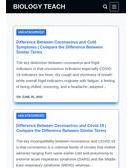In This Topic, we discuss in a detailed account of the ORIGIN OF ANGIOSPERMS. Angiosperms from the most dominant group of plants with at least 253,300 species (Thorne, 2007). Angiosperms are also found in a far greater range of habitats than any other group of land plants. The phylogeny of angiosperms is a much-debated subject, largely because of very poor records of the earliest angiosperms. These earliest angiosperms probably lived in habitats that were not best suited for fossilization.
With the exception of conifer forest and moss-lichen tundra, angiosperms dominate all major terrestrial vegetation zones, account for the majority of primary production on land, and exhibit extensive morphological diversity.
Unfortunately, much less is known about the origin and early evolution of angiosperms, resulting in a number of different views regarding their ancestors, the earliest forms, and the course of evolution. The origin of angiosperms may be conveniently discussed under the following considerations.
Angiosperms form a distinct group of seed plants sharing a unique combination of characters. These important characters include carpels enclosing the ovules, pollen grains germinating on the stigma, sieve tubes with companion cells, double fertilization resulting in the triploid endosperm, and highly reduced male and female gametophytes.
The angiosperms also have vessels. The pollen grains of angiosperms are also unique in having non-laminate endexine and ectexine differentiated into a foot-layer, columellar layer, and tectum. The angiosperm flower typically is a hermaphrodite structure with carpels surrounded by stamens and the latter by petals and sepals, since insect pollination prevails.
Arbuscular mycorrhizae are also unique to angiosperms. The vessel elements of angiosperms typically possess scalariform perforations. There may be individual exceptions to most of these characters. Vessels are absent in some angiosperms (Winteraceae) while some gymnosperms have vessels (Gnetales).
The flowers are unisexual without perianth in several Amentiferae, which also exhibit anemo-phily. In spite of these and other exceptions, this combination of characters is unique to angiosperms and not found in any other group of seed plants.
What is the age of Angiosperms?
The time of origin of angiosperms is a matter of considerable debate. For many years, the earliest well-documented angiosperm fossil was considered to be the form-genus Clavito-pollenites. Couper, (1958) described from Barremian and Aptian strata of Early Cretaceous of southern England (132 to 112 mya-million years), monosulcate pollen with distinctly sculptured exine, resembling the pollen of the extant genus .
Brenner and Bickoff (1992) recorded similar but inaperturate pollen grains from the Valanginian (ca 135 mya) of the Helez formation of Israel, now considered to be the oldest record of angiosperm fossils (Taylor and Hickey, 1996).
The number and diversity of angiosperm fossils increased suddenly and by the end of the Early Cretaceous (ca 100 mya) period major groups of angiosperms, including herbaceous Magnoliidae, Magnoliales, Laurales, Winteroids, and Liliopsida were well represented.
In Late Cretaceous, at least 50 percent of the species in the fossil flora were angiosperms. By the end of the Cretaceous, many extant angiosperm families had appeared. They subsequently increased exponentially and constituted the most dominant land flora, continuing up to the present.
The trail in the reverse direction is incomplete and confusing. Many claims of angiosperm records before the Cretaceous were made but largely rejected. Erdtman (1948) described Eucommiidites as a tricolpate dicotyledonous pollen grain from the Jurassic which had bilateral symmetry instead of the radial symmetry of angiosperms and granular exine with gymnospermous laminated endexine.
This pollen grain was also discovered in the micropyle of seeds of the female cone of uncertain but clearly gymnospermous affinities. Several other fossil pollens from the Jurassic age attributed to Nymphaeaceae ultimately turned out to be gymnosperms.
In the last few years fossils of Archaefructus from Upper Cretaceous (nearly 124 mya) of China, with clearly defined spirally arranged conduplicate carpels enclosing ovules, a feature not reported in earlier angiosperms. The fruit is a follicle. This is considered to be the oldest record of the angiosperm flower.
Several vegetative structures from the Triassic were also attributed to angiosperms. Brown (1956) described Sanmiguilea leaves from the Late Triassic of Colorado and suggested affinity with Palmae. A better understanding of the plant was made by Cornet (1986, 1989), who regarded it as a presumed primitive angiosperm with features of monocots and dicots.
Although its angiosperm venation was refuted by Hickey and Doyle (1977), Cornet (1989) established its angiosperm venation and associated reproductive structures. Our knowledge of this controversial taxon, however, is far from clear.
Marcouia leaves (earlier described as Ctenis neuropteroides by Daugherty, 1941) are recorded from the Upper Triassic of Arizona and New Mexico. Its angiosperm affinities are not clear. Harris (1932) described Furcula from the Upper Triassic of Greenland as bifurcate leaf with dichotomous venation.
Although it seems to approach dicots in venation and cuticular structure, it has several non-angiospermous characters including bifurcating midrib and blade, higher vein orders with relatively acute angles of origin (Hickey and Doyle, 1977). Cornet (1993) has described Pannaulika, a dicot-like leaf form from Late Triassic from the Virginia-North Carolina border.
It was considered to be a three-lobed palmately veined leaf. The associated reproductive structures were attributed to angiosperms but it is not certain that any of the reproductive structures were produced by the plant that bore Pannaulika. Taylor and Hickey (1996), however, do not accept its angiosperm affinities, largely on the basis
What are the possible ancestors of angiosperms?
Ancestry of angiosperms is perhaps one of the most controversial and vigorously debated topics. In the absence of direct fossil evidence, almost all groups of fossil and living gymnosperms have been considered as possible ancestors. Some authors even suggested the Isoetes origin of monocotyledons because the plant has a superficial resemblance with onion, although no trace of seed habit.
The various theories have revolved around two basic theories, viz., the Euanthial theory, and the Pseudanthial theory of angiosperm origin. Some other theories projecting herbaceous ancestry for the angiosperms have also recently received attention, making the question of ancestry of angiosperms rather more ambiguous:
Also known as Anthostrobilus theory, Euanthial theory was first proposed by Arber and Parkins (1907). According to this theory, the angiosperm flower is interpreted as being derived from an unbranched bisexual strobilus bearing spirally arranged ovulate and pollen organs, similar to the hermaphrodite reproductive structures of some extinct Bennett Italian gymnosperms. The carpel is thus regarded as a modified megasporophyll
The bisexual flower of Magnoliales has been considered to have evolved from such a structure. Also agreeing with this general principle, various authors have tried to identify different gymnosperm groups as possible angiosperm ancestors: Cycadeoidales (Bennettitales) The group, now better known as Cycadeoidales, appeared in the Triassic and disappeared in the Cretaceous.
Their potential as angiosperm ancestors was largely built upon the studies of Wieland (1906, 1916). Lemesle (1946) considered the group to be ancestral to angiosperms, primarily because of the hermaphrodite nature of Cycadeoidea, which had an elongated receptacle with perianth-like bracts, a whorl of pollen-bearing microsporophylls surrounding the ovuliferous region having numerous.
The plant was believed to look like cycads with a short compact trunk and a crown of pinnate compound leaves. It was earlier suggested that the microsporophylls opened at maturity but the subsequent studies of Crepet (1974) showed that microsporophylls were pinnate, and distal tips of pinnae were fused, the opening of the region was not structurally possible, and they later disintegrated internally. The ovules were terminal in contrast to their position in carpels of angiosperms.
Cycadales: Sporne (1971) suggested possible links between Cycadales and angiosperms in the palm-like habit of Cycadales. The ovules being borne on leaf-like megasporophylls. Trends in the reduction of sporophyll blade as seen in various species of Cycas. Although it may be difficult to assume Cycadales as ancestral to angiosperms.
Commonly associated with the Englerian School, the theory was first proposed by Wettstein (1907), who postulated that angiosperms were derived from the Gnetopsida, represented by Gnetum, and Welwitschia (formerly all placed in the same order Gnetales).
The group shows more angiosperm characteristics than any other group of living or fossil gymnosperms. These include the presence of vessels, reticulate dicot-like leaves (Gnetum), male flower with perianth and bracts, strong gametophyte reduction, and fusion of the second male gametophyte with the ventral canal nucleus.
Ephedra resembles Casuarina inhabit. Wettstein homologized the compound strobili of Gnetales with the inflorescences of wind-pollinated Amentiferae. Showy insect-pollinated bisexual flowers of Magnolia as pseudanthia derived by aggregation of unisexual units, the carpel thus representing a modified branch (Stachyosporous origin of carpel).
Gnetopsida is a very young group. But this theory has been strongly supported by Young (1981), who challenged the view that first angiosperms were vessel less and assumed that vessels were lost in several early lines.
Muhammad and Sattler (1982) found scalariform perforations in vessel-elements of Gnetum, suggesting that angiosperms may be derived from Gnetales after all. Ephedra is generally considered to be the most primitive of the three living genera of gnetopsids. Cornet believes that Archaestrobilus possessed characters that may be plesiomorphic even for Ephedra.
This theory is a modified version of the pseudanthial theory and was proposed by Neumayer (1924). According to this theory, the angiosperm flower has several separate origins (i.e. angiosperms are polyphyletic). In most Magnoliidae and their dicotyledonous derivatives, they are modified paraxial systems (holanthocorms). They originated from the gnetopsids through the Piperales.
The Gonophyll theory was developed by Melville, largely on the basis of a study of the venation pattern. He derived angiosperms from Glossopteridae, which formed important elements in the flora of Gondwanaland. He further derived angiosperm flower from gonophyll (a fertile branching axis adnate to a leaf).
The consensus is emerging from recent phylogenetic studies that gnetopsida represents the closest living relatives of angiosperms, whereas the closest fossil group is the Bennettitales. Angiosperm lineage, together with these two groups, constitutes Anthophytes. The group is believed to have split in the late Triassic. The angiosperm lineage continuing as Angiophytes up to the Late Jurassic when it further split into stem Angiophytes and crown Angiophytes.
Image Courtesy:


